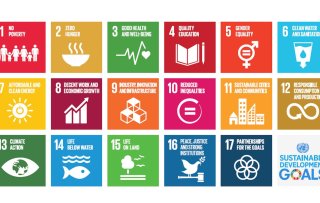From November 30 to December 12, the United Nations' annual climate conference is taking place in Dubai. It marks the 28th edition of the 'Conference of the Parties' addressing global climate change. The gathering, commonly known as ‘COP28,’ is featuring Food & Agriculture for the first time.
Leaders from nearly two hundred countries are expected at the summit. U.S. Vice President Kamala Harris will be present, along with Secretary of State Antony Blinken and climate envoy John Kerry. The 193 participating countries have committed to reducing their greenhouse gas emissions in earlier climate conferences; in this 28th meeting, they are reassessing their climate promises and intentions. For the first time, participating countries will also present the current status and impact of their climate policies; 50% of these countries have fallen behind on these commitments. And only 11 out of the 193 participating countries appear to be on track to achieve their goals, including Russia, China, and India. On a parallel track, global greenhouse gas emissions have increased since the first climate summit in Berlin in 1995.
Food & Agriculture on the agenda
For the first time since the inception of climate conferences, Food & Agriculture is a significant topic. Discussions will revolve around the impact of the global food system on the climate crisis, and exploring possibilities to limit CO2 emissions from this system.
During COP28, presentations and speeches by NGOs, government leaders, and advocacy groups will take place. Simultaneously, negotiations behind the scenes will determine a joint declaration. The importance of a plant-based menu and the progress of the protein transition will also be addressed during COP28. According to Oxford University a plant-based diet can lead to a 75% reduction in CO2 emissions, water pollution, and land use compared to an animal-based diet.
Food Systems Pavilion
Within the conference center, a Food Systems Pavilion will be featured. The pavilion, a collaboration between various international food companies, will run parallel to the COP 28 program and includes a daily agenda focused on varied themes that include regenerative farming, nutrition and health, soil health and reducing food loss.
Facts on climate change
-
Since the early 19th century, the earth has warmed by approximately 1.2 degrees. In the North Pole, temperatures are 3 degrees higher than in 1980.
-
The global food system accounts for 25 to 35% of all CO2 emissions, making the agrifood sector, after the fossil fuel industry, the most significant polluter.
-
Since 1990, the Intergovernmental Panel on Climate Change (IPCC) has published six reports. The sixth report, released in March 2023, is a synthesis that contains the most recent data on climate change, including the compilation of 14,000 scientific studies.
-
These studies conclude that human activities are responsible for over 100% of the earth's warming caused by greenhouse gas emissions. The IPCC asserts: 'It is indisputable that human influence has warmed the atmosphere, ocean, and land.'
-
According to the IPCC, the decisive moment to reduce CO2 emissions is now. To prevent the average global temperature from rising more than 1.5 degrees, a significant reduction in emissions must occur in the coming years. The IPCC states that by 2030, greenhouse gas emissions must be halved, and by 2050, the world should achieve net-zero emissions.
-
A simple calculation underscores the urgency. The global carbon budget expected to remain within the 1.5-degree warming limit was estimated at a maximum of 500 gigatons in 2020 (1 gigaton is a thousand billion kilograms). The industrialized world emits about 40 gigatons of CO2 annually. Since emission reduction efforts have fallen short in recent years, there is still 'room' for 380 gigatons of CO2 before reaching the tipping point of 1.5-degree warming. However, with current policies, estimates suggest we could approach 60 billion tons per year by 2030.
-
If we fail to reduce emissions, we will deplete our 'budget' within a decade, and 1.5-degree warming by 2050 will become a reality. A continued annual emission rate of 40 gigatons could lead to a predicted warming of 3 degrees by the end of the century. A rate of 4 to 5 degrees is no longer deemed impossible.
.jpg-28x28.jpg) Written by
Written by 

.jpg-300x300.jpg)
.jpg-50x50.jpg)









